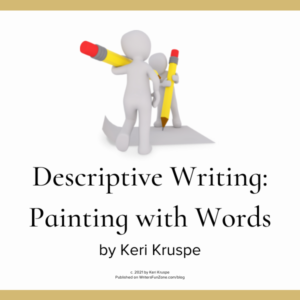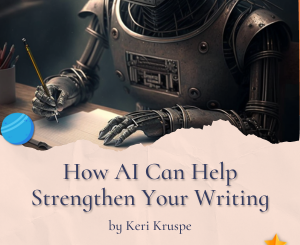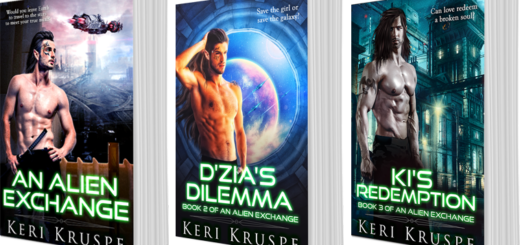Descriptive Writing: Painting with Words by Keri Kruspe
 Let’s welcome back monthly columnist Keri Kruspe as she shares with us “Descriptive Writing: Painting with Words” Enjoy!
Let’s welcome back monthly columnist Keri Kruspe as she shares with us “Descriptive Writing: Painting with Words” Enjoy!
***
I love descriptive writing.
Even though I didn’t know it was the “official” term for what I did, I’d been exercising my descriptive writing muscles throughout every book I’ve published.
When I first heard the term in a Master Class, I explored the concept closer. After all, getting lost in creating new worlds inhabited by new people (or unusual aliens) is what inspires me to write!
What is Descriptive Writing?
In its purest definition, descriptive writing is describing a person, place, or thing in such a way that a picture forms in the reader’s mind.

Descriptive writing involves paying close attention to the details, using all five senses and the following techniques:
- Analogies, similes, and metaphors
- Precise language using specific adjectives, nouns, and strong action verbs.
- Being organized. This may include elements like chronology (time), location, and order of importance.
- When describing a person, it includes a physical description along with how the person thinks, feels, and acts.
Let’s dive deeper.
How to Incorporate Descriptive Writing
Describing helps the reader clearly imagine places, characters, and objects, and there are many ways to do this:
The Almighty Adjective
One of the best ways to get the most out of an adjective is to look up the word origins to get a clearer idea if it’s the right word to use.
If you’re trying to describe an “oxymoron”, the word originates from the mid-17th century from Greek oxumōron, neuter (used as a noun) of oxumōros ‘pointedly foolish’,
Use Words that Describe More than Appearance
An old building could be a ramshackle old building. A person could be vivacious and sprightly instead of young. Avoid just using physical aspects (i.e. eye color) by themselves. Add a sprinkling of “gentle” or “piercing” to eyes that are “more green than blue.”
Example: “His all-black coat glistens in the late afternoon sun. His face displays a strong confidence with his nostrils flared, his veins bulging from his cheekbones, and his fiery black eyes burning holes into the souls of those who stare into them.” —Jamell Wilson, 2005
When Describing a Place, Start With the First Thing That Strikes You about It
Think about what you would notice first.
On a building do you first notice a sign? a window? or the material it was built with? Consider focusing on an attribute you’d be elaborating later in the story.
Example: “It wasn’t that the building was tall, it was. It shot straight from the ground into the clouds and seemed to go for miles.”
Make the Readers Feel What It’s Like to Be in the Place
Add sensory details to appeal to your sense of smell, touch, or hearing.
Examples:
-
“The lightbulb threw off a blaze so bright it was almost violet.”
-
“The bag crinkled sharply when opened.”
-
“The wood of the tree was biting and rough enough that it scratched her hand when she brushed against it.”
-
“The spaghetti was so garlicky and salty he gulped a whole glass of soda after one bite.”
Use Character Point of View (POV) to Filter Descriptions
Using the POV of my character is one of my favorite ways to describe another person or place.
An introverted character would describe the noise and action at a party much differently than an extrovert would.
If you have multiple points of view in your story, you might show the scene from their different viewpoints.
When you filter the description through a character POV, it’s a way for the reader to feel and think about what that character does. Using this subtle way to describe their personalities helps make your characters real.
For example, Donna Tartt in The Secret History describes her character Bunny (Edmund) Corcoran like this:
“He wore the same jacket every day, a shapeless brown tweed that was frayed at the elbows and short in the sleeves, and his sandy hair was parted on the left, so a long forelock fell over one bespectacled eye.”
The description of this man’s clothes is a precursor to his character. Further on in the story, we learn Bunny has a “honking” voice who is invasive and unreflective. Given these clues throughout the story, it deepens what the reader expects from the character.
Have a Rich Vocabulary of Words Handy for Your Descriptions
One of the easiest ways to categorize your characters is to divide them into the four simple types:
- Sanguine: Bubbly/animated/emotional
- Melancholic: Gloomy/dispirited/miserable
- Phlegmatic: Calm/steadfast/gentle
- Choleric: Reactive/outspoken/angers easily
So, if your heroine has a sanguine personality, she won’t dress all in black and frown at people. She might love the color yellow, bounce when she should stand still, and speak rapidly, so she’s hard to understand.
You get the idea.
A favorite tool of mine is The Emotion Thesaurus (second edition) by Angela Ackerman and Becca Puglist.
I was giddy with joy when they came out with the second edition. My copy of the first edition was so dog-eared, I had to put a rubber band around it to hold it together!
Another favorite tool of mine is author Kathy Steinemann’s word lists.
I have a whole binder filled with her suggestions, and I’ve had to buy new binders every year or the darn thing falls apart because I keep adding to it.
Use Descriptive Writing Wisely
All this is excellent advice—if you don’t go overboard.
Going into too much detail will slow down your narrative and overwhelm the reader.
It’s like cooking with too much salt. Use too much, and it makes the food inedible, but sprinkle just the right amount, and your taste buds will sing with joy.
If we do our job, our descriptions will form a perfect picture for our readers without interrupting the flow of the story, and the best descriptions will draw the reader in, keeping them glued to your story with rapt attention.
After all, isn’t that why we write?
***
Want to read more articles like this one Writer’s Fun Zone? Subscribe here.
***
ABOUT THE AUTHOR

Keri Kruspehas been an author since the age of twelve and has always been fascinated with otherworldly stories that end in Happily Ever After. Author of Otherworldly Romantic Adventures, Keri’s first series is An Alien Exchange trilogy. An Alien Exchange is the first book in the arousing Alien Exchange sci-fi romance series. If you like sexy aliens, feisty heroines, and fast-paced action, then you’ll love Keri Kruspe’s steamy space adventure.
Keri now resides with her family in the wilds of Northwestern Michigan. An avid reader, Keri enjoys good wine, good food, and watching action/adventure movies. You can find her most days immersed in her fantasy world of writing or traveling with her hubby in their RV, discovering intelligent life here on Earth. For goodies, news of upcoming releases, sign up for her newsletter at www.kerikruspe.com.











I think I’m going to start a binder (Maybe an e-binder online) and this post will be the FIRST page. Thanks for the detailed ideas and examples.
Great article, Keri! Love it! And thank you so much for being a writer for Writer’s Fun Zone! What a great chronicle of tips.
Thanks Hugh! I’m thrilled with your encouragement.
Thanks for the mention, Keri. May friendly alien muses accompany you while you write and fill your mind with new story ideas.